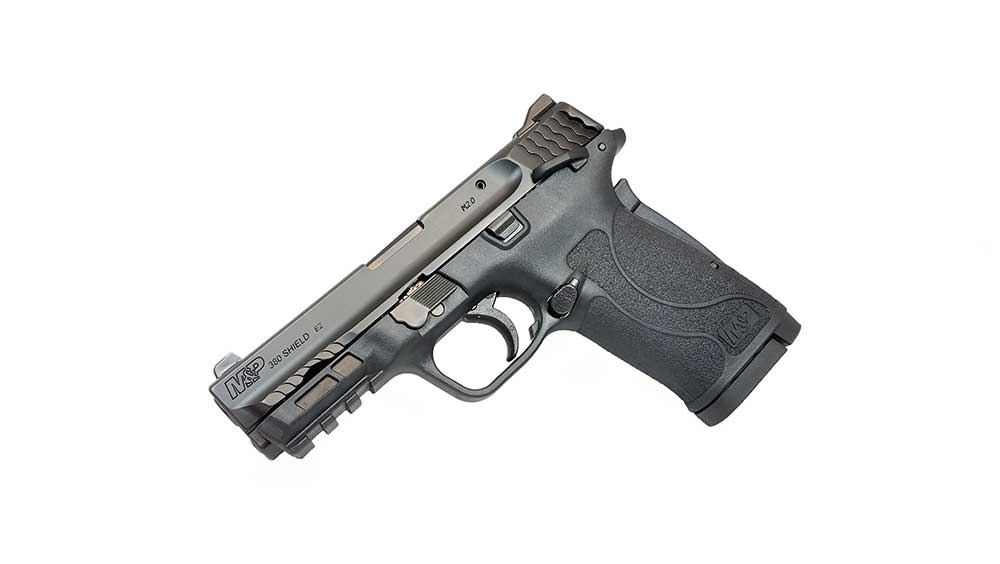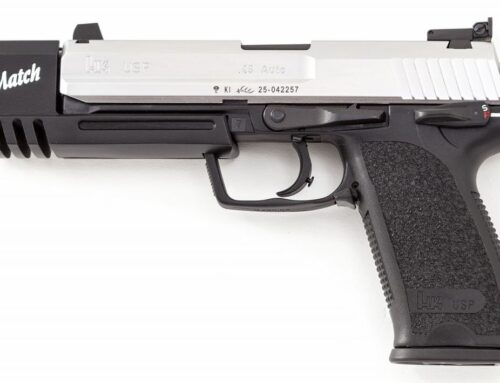Chances are that you’ve heard of Smith and Wesson’s M&P and Shield pistol lineup by now. It wasn’t that long ago that I had reviewed the Shield 2.0 and thought quite highly of it. I know I’m not the only one who was a little surprised to hear about this new model which not only dips into the sub-9mm range but also steps outside of the traditional M&P mold. What we have here is a pistol which is a Shield only by name and rough appearance. Under the hood this new ‘EZ’ model is something entirely unique.
Now what’s this ‘EZ’ business about? This new .380’s unique badge represents an easier to rack slide. Many of the compact and sub-compact pistols have very short and very stout springs which can be difficult to operate. This holds doubly true for many .380 pistols which are designed to be as small as possible. Generally this also means that they’re straight blowback operation, which means even stiffer springs.
This particular .380 feels more like operating a typical .22 pistol. It operates with a tilting barrel lock more like standard sized 9mm pistols, meaning the springs can be lighter (and it runs cleaner than blowback guns.) In addition the very back edge of the slide has been slightly enlarged (if you’re familiar with the HK VP9 then you’ll know what I’m talking about here.) This gives the operator a more solid purchase while racking the slide without being obtrusive. It’s a nice touch, though while I don’t feel that a sidearm like this needs the extra gripping surface, it all lends to that ‘EZ’ tag which it wears.
Despite reducing the amount of effort required to operate, I was happy to find that the recoil wasn’t bad at all. It’s a very rare event for me to find a .380 which I enjoy shooting, but the tilting barrel lock definitely gave the 380 Shield an advantage over other models. Further aiding to its controllable and even-tempered demeanor, this model is built large enough to fully fit your hand. No pinky hanging off of the bottom of the frame for me! Double taps and swift follow-ups are easily managed, something which I cannot often say for anything chambered in .380.
There are a few other peculiarities to this model. For one, it isn’t striker-fired. Disassembly works like any other M&P pistol, but inside you’ll find a fully concealed hammer. The trigger safety has been left to its striker-fired siblings which, in my opinion, makes this trigger a nicer place to visit for my index finger. Instead they’ve given this model a grip safety. (Stay with me here, guys.) It can also be had with an ambi thumb safety if you prefer the additional peace of mind.
Yes, it has a grip safety. I’ll be honest with you here, I think grip safeties are really smart for concealed carry guns. With a grip safety you need to have your hand fully around the grip in order to fire. There’s no perceptible spring tension, nothing digs into your hand, and it’s virtually impossible to get a grip on a gun like this without fully disengaging the safety. This design seems to have worked out pretty well for the 1911 which is still going strong more than a hundred years later!
Safety tangent aside, how’s this guy shoot? Pretty good! I must note here that this pistol is not capable of safely firing +P and +P+ ammunition. Keep to a strict diet of standard power loads with your 380 EZ. I kept my test shots to the 21 foot mark and tried three different drills. ‘Comfort’ shooting, which was more at my own pace. Double-taps, and a more controlled group for accuracy. Each set was a full magazine of eight rounds printing on a round target 8 inches in diameter.
The ‘comfort’ group measures just shy of 2.5 inches. Double-taps opened this up to about 6.75″ but kept within the target area. The accuracy group surprised the heck out of me. Somehow I managed to print an almost perfect square, 1.5″ from the furthest two corners. Here’s the kicker, somehow I managed to land eight shots into four holes. Maybe it’s a fluke but credit where credit’s due. I’m not so great with accuracy out of smaller pistols but there you have it.
The Shield 380’s controls are easy to reach and operate. The model which I had tested had the ambi thumb safety which also seems to work as a thumb rest if you like to ride high on your semi-autos. The trigger is more than up to the task with a little take-up and a crisp break along with a comfortably short reset. A ‘lever’ style loaded chamber indicator can be found along the top center of the slide, non-obtrusive and kept uniformly black in color. This model had standard three dot sights installed, not night sights.
One more detail which needs to be mentioned is the physical size of this pistol. Many .380’s are made as tiny as possible, which makes them a right pain in the backside to operate. The 380 EZ is not only bigger than most other .380’s but a little bigger than some of the sub-compact 9mm’s currently on the market. This kind of made me curious as to what role this gun would best play. I figure that it would serve well as a home defense or bedside gun for anyone needing an easier to rack sidearm. The Picatinny rail gives you somewhere to put a flashlight, the grip safety means it’s easily made ready, and the size makes it a comfortable companion without seeming like it’s going to sucker-punch you when you take that first shot.
Complaints? Not a whole lot! The single stack magazine holds 8 rounds and has a thumb button on the left side of the mag body to assist with loading similar to many .22 pistols. Bearing in mind that I’m reviewing a brand new model and not one that’s been broken in, I found the mag spring to be quite stiff. By the sixth round that thumb assist on the side was really starting to hurt. I found it easier to load right from the top like a typical mag.
My second issue has already been addressed by Smith & Wesson. By sheer luck of the draw the very first box of ammo I took off of the shelf revealed an uncommon anomaly with the manual thumb safety. I was using Fiocchi which must have been somewhat hotter of a round as the recoil would activate the safety after one or two shots had been fired. As it turns out this is a spring issue in the safety itself, one which Smith & Wesson is aware of and is already offering an upgrade for. When I tried a different brand of ammo this issue never returned.
Last up, we did experience a few failures to feed. This could certainly be New Gun Syndrome, where it’s still being broken in, though a couple of us are wondering if the recoil spring might be a little TOO light as a bump to the back of the slide immediately took care of these hiccups. Less spring tension also means less resistance upon the slide, meaning that every time it’s fired more of the recoil impulse is being transferred into the frame. I couldn’t say if this would have any negative effects on the pistol over time.
The Shield 380 EZ is an interesting new addition to the M&P lineup, and one which I happen to welcome. It’s easy to operate, light in weight, not punishing to shoot, competitively priced, comfortable in the hand, and it brings something new to a crowded market. Come take our rental for a spin down at the Range of Richfield!








